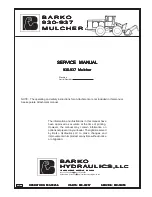
OPERATION
33
Flushing the Spray System and Tank Cleaning
Daily Cleaning
Follow the disposal and rinsing guidelines outlined
by the chemical manufacturer to properly flush the
spray system of different types of chemicals.
Always consult with your state or local
agricultural department and the chemical
manufacturer for precautions to be taken when
handling, as well as the laws that govern the
safe disposal of specific chemicals.
WARNING: AVOID INJURY! Wear eye
protection, protective gloves and
clothing whenever handling pesticide
contaminated material. Protective gloves must
be unlined materials, made of rubber,
polyethylene, or neoprene. CHECK THE
PESTICIDE LABELS FOR DIRECTIONS ON
PROTECTIVE CLOTHING TO BE WORN WHILE
HANDLING A PESTICIDE.
WARNING: Solution contained in the
plumbing tree and hoses will empty
when any hoses, dust caps, or plugs
are removed to drain the spray
system.
After each working day using the sprayer, the tank
should be rinsed clean using the following
procedure:
1. When the tank has been emptied and no
chemical remains in the boom lines, fill the
main tank with 50 to 100 gallons (200 to 400
liters) of clean water.
NOTE: The first rinse solution will contain
the highest concentration of chemical. Adding
more water to the tank will reduce the
concentration but will take longer to flush
empty.
2. Circulate water in the front and rear tanks by
turning the main suction valve (A) to the
normal spraying position and close the bypass
valve (B).
3. Open the agitator valve and allow the spray
system to circulate for 5 minutes.
NOTE: While flushing the spray system,
the optional rinse nozzles can be used to flush
the inside surfaces of the tank. Refer to the
section on page 85 for instructions on
operating the rinse nozzles installed in each
solution tank.
4. Reduce the application rate and flush the spray
system through the booms by spraying the
tank contents on the crop previously sprayed
or a fallow field.
Switch the run/hold switch on the MT-3405 rate
controller to “RUN” and switch the boom
selector switches to “ON”. This will flush clean
water through the nozzle tips.
5. Repeat the procedure TWICE.
6. After rinsing the tank, clean the filters, screens
and nozzles. Drain the tank and allow it to dry.
Drain the spray system through the bottom fill
coupling. Remove dust cap from the bottom fill
coupler and partially turn valve A until the
solution begins to drain.
Plumbing System
A
B
C
















































